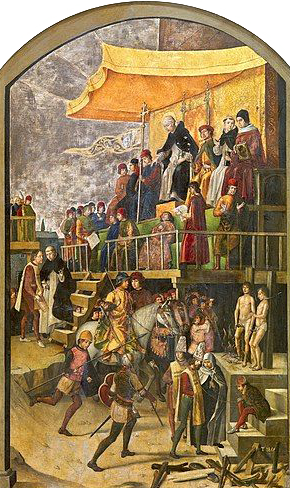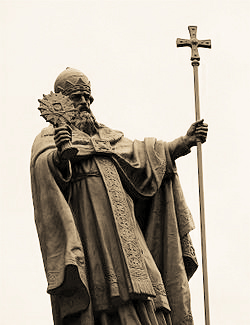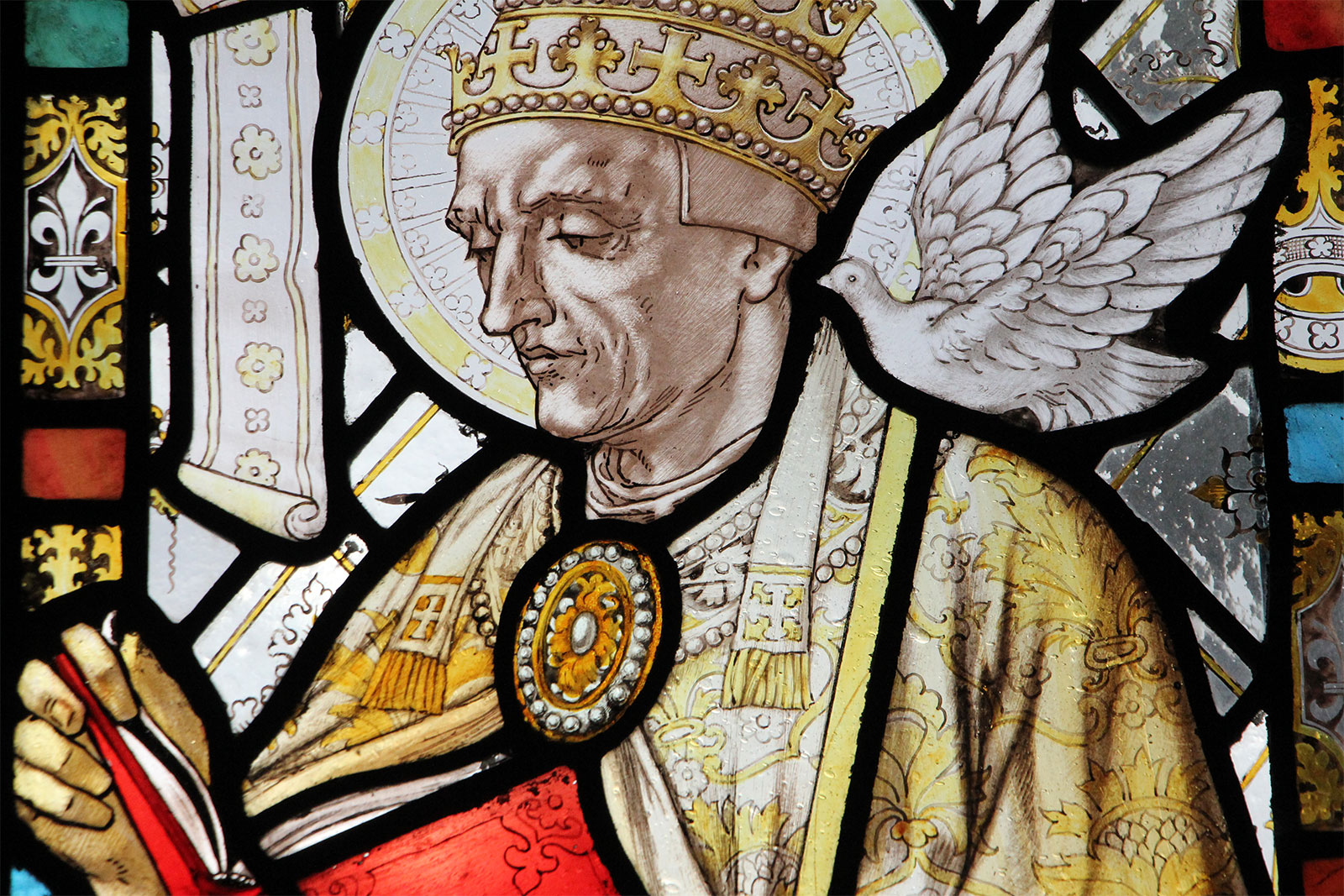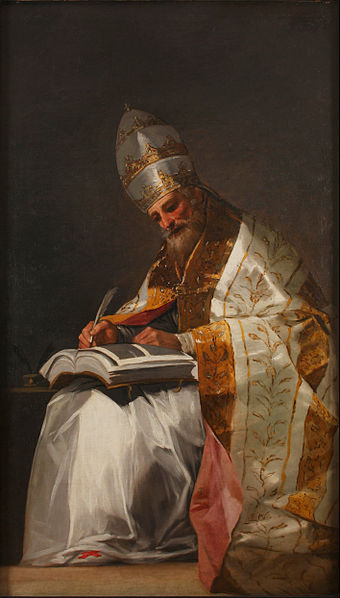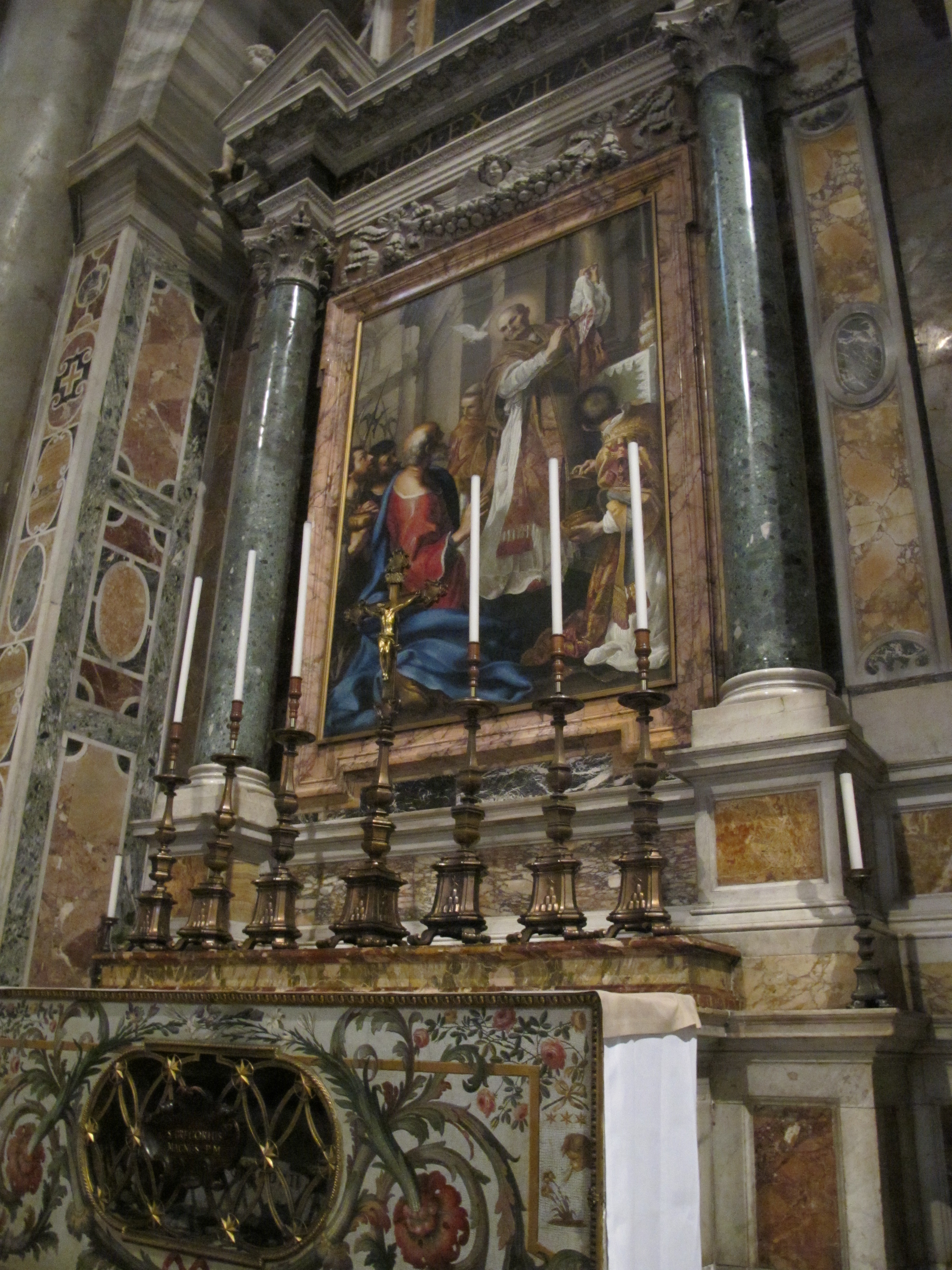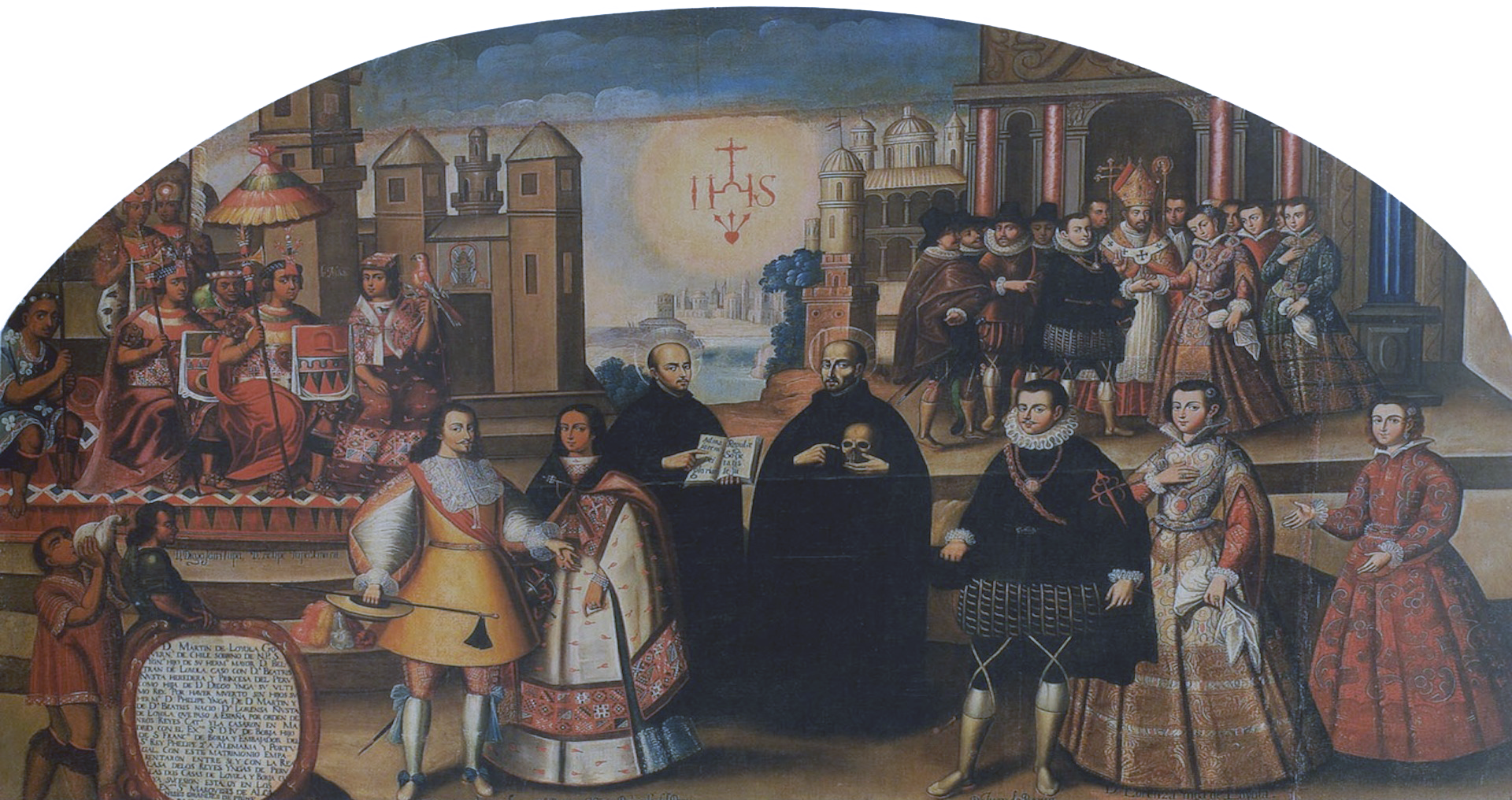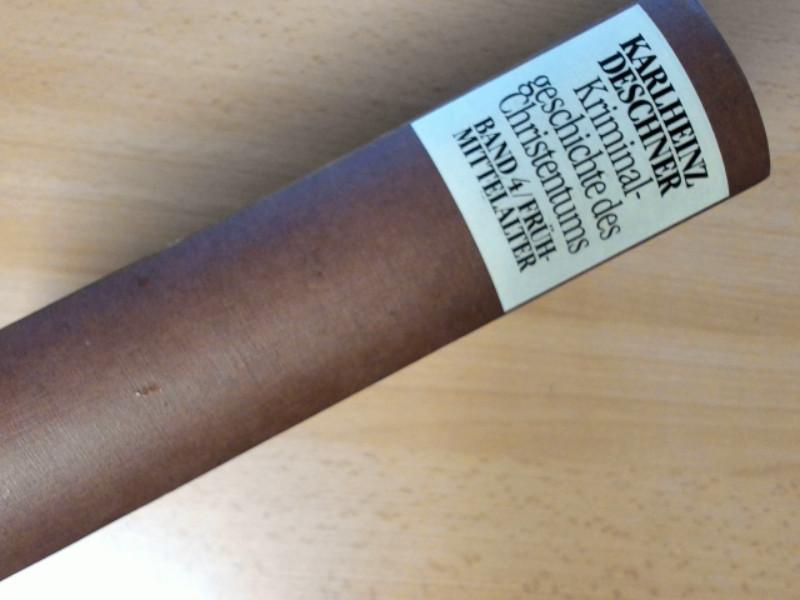– For the context of these translations see here –
VOLUME IV, CHAPTER 1
THE CHRISTIANISATION OF THE GERMANS
‘The introduction of Christianity among the Germans was the most precious gift from heaven’. —Pastoral letter from the German episcopate, June 7, 1934
The spread of Christianity in the West
At the end of Antiquity and during the succeeding centuries, Christianity conquered the Germanic world. By armies and merchants it had spread beyond northern Gaul to the Rhine. In the old Rhineland provinces probably there were Christian communities as early as the end of the 3rd century; churches were erected from Constantinian times in Bonn, Xanten, Cologne and, especially, in Trier: the official residence of Caesar since 293. At the end of the 4th century, Christianity was already the dominant religion in some Rhineland areas because ‘the laws of Theodosius, Gratian and Valentinian II imposed its entry into those lands…’
In the late 5th century evangelisation of the Franks began; at the end of the 6th century that of the Anglo-Saxons and the Lombards; in the 9th century the Christianisation of northern Europe was undertaken and, at the end of the millennium, that of the Czechs, Poles, and Hungarians. Since Christianity was no longer a despised religion as it had been in pre-Constantinian times, but the official religion of an empire, the popes no longer trapped some individuals but entire peoples in their net. They also annihilated entire towns ‘leaving neither green nor withered’, as the father of the Church, Isidore, boasts. Such was the case, for example, with the Ostrogoths and the Vandals, of whom the Marseillaise monk Prosperus Tironis provided an insightful picture of the Middle Ages, and who were often the subject of ‘cruel propaganda’ (Diesner).
Conversion methods
The Christianisation of the Germanic peoples—designated in the sources as nationes, gentes, populi, civitates, etc.—not only took place at very different times but also in very different ways. Two typical Christian activities converged in the Germanic mission: preaching and destruction. In Merovingian times, preaching was not the primary instrument of mission. There was a more eloquent method to demonstrate to the pagans the impotence of their Gods and the supreme power of the Christian god: the destruction of the Gentile sanctuaries… Of course it was not only destroyed; often, the so-called Christianisations were ‘simply’ arrived at. In other words, Gentile temples were transformed into Christian churches, expelling evil spirits through rites of exorcism and re-consecrating the buildings. The church transformed and incorporated everything that seemed useful, destroying everything else as a nefarious work of the devil.
An important motive in the conversion of the pagans, and also in the mentoring of those already converted, was without a doubt the constant infiltration of scruples and fears in an alarmist attitude that sowed fear for centuries. Fear, in effect, was ‘the characteristic state of the common man in the Middle Ages: fear of the plague, fear of invasion by foreign armies, fear of the tax collector, fear of witchcraft and magic and, above all, fear of the unknown’ (Richards). The priests of many religions feed on the fear of those whom they lead, and especially Christian priests. It is very significant that St. Caesarius of Arles (died in 542), an archbishop absolutely faithful to Rome, in almost all his propaganda interventions, which number more than two hundred, scares the readers with ‘the final judgment’. Whatever the occasion of his homiletical effusions, he rarely fails to insistently evoke the ‘court of Christ’, the ‘eternal judge’, his ‘harsh and irrevocable sentence’, etc.
The conversions of pagan Germans to Christianity were frequently due to purely material motives, already acting for ‘reasons of prestige’, especially when they came under the tutelage of Christian neighbours. Illustrious Gentiles could be chased ‘like dogs’ from the banquets of their princely courts, because Christians were forbidden to sit at the same table with pagans. It is symptomatic that also among Bavarians, Thuringians and Saxons, the nobility was the first to immediately prostrate themselves before the cross…
Jesus becomes the Germanic broadsword
With its acceptance by the Germans, Christianity was also nationalised and Germanised from the beginning. And not only in epic poems did Christ appear to German eyes as a kind of popular and cantonal king. The Franks were immediately seen as his special courtship, his chosen and preferred people. Warriors clustered around him, just as they clustered around princes. The saint is also now felt as the herald of Christ and god. Traditional Christian concepts are filled ‘with totally new content: Germanic, aristocratic and warrior content’ (Zwolfer). ‘From the religion of patience and suffering, from the flight and denial of the world, the medieval Germans made a warlike religion; and of the Man of Sorrows a Germanic king of the armies, who with his heroes travels and conquers the lands and who must be served through struggle. The German Christian fights for his Lord Christ, as he fights for the landlord he follows; even the monk in his cell feels like a member of the militia Christi’ (Dannenbauer). And naturally the clergy knew how to make the Germans proud of having converted to the Roman cross. In the prologue to the Salic law, the oldest hereditary right of the Franks, the fact of conversion is thus exalted:
Unclean people of the Franks, created by God himself, brave with arms, firm in the covenant of peace, profound in counsel, of great corporal nobility, of uncontaminated purity and superior complexion, bold, prompt and fiery—become to the Catholic faith, free from heresy.
Indeed, according to Christian doctrine, all peoples have been created by god; but flattery is always greatest where it is most needed. In this way the Franks appear here occupying the place of the chosen people of the Bible, of the people of Israel. And in a more recent prologue to the aforementioned Salic law, Christ also appears as the legitimate sovereign of the gens Francorum. He appears ‘personally before the Franks’. He loves those who are far superior to the old world power, ‘the chosen people of a new alliance’. ‘They have defeated the Romans and they have broken the Roman yoke’…
Undoubtedly, many German princes converted for purely political reasons. They worshiped in Christ the ‘strong God’, and especially the superior captain, to whom he granted victory. Thus the Frankish Clovis, Edwin of Northumbria and the Vikings converted—all of whom were baptised after having cast a vow and carried out a slaughter. And just as old Odin was considered a ‘God and lord of victory’ and Wotan (Odin’s name in the south) was considered a warrior God, so Christ is now seen as the same. He occupies the place of the ancient Gods of battle, he is politicised and mythologised, presenting him ‘almost as a national God’ (Heinsius). And from now on it will be a matter of honour for each Christian king to fight ‘the barbarians, who by their very condition as pagans are out of the order of the world’.
The Franks, educated in believing fanaticism, considered it their duty and right to ‘fight for Christ’ (Zollner). And still in the 7th and 8th centuries the Frankish Christians had themselves buried with their weapons, under the old pagan belief of survival after death. On a tombstone found in the Frankish cemetery of Niederdollendorf, near Bonn there is even a risen Christ holding in his right hand the spear, the Germanic sign of sovereignty, instead of the staff of the cross.
It is understandable that the Old Testament, often so bloody, was in tune with the men of the Middle Ages better than the partly pacifist New Testament; and it is understood that the Old Testament kings were exalted by proposing them as models of the Frankish princes, who liked to compare themselves with them. For the historian Ewig, this constitutes a new stage ‘in the Christianisation of the idea of the king’…
Among the Carolingians, decisive victories were frequently attributed to the attendance of St. Peter. ‘But now rest assured’, declares Pepin to the papal legate Serge in the battle against the Bavarians, ‘because due to the intervention of St. Peter, Prince of the Apostles, by divine decree Bavaria and the Bavarians belong to the sovereignty of the Franks’. Even minor achievements, such as the conquest of a fortress or even the discovery of a fountain during the war against the Saxons in 772 are presented as great divine miracles. But when misfortune befell—and it happened so often!—the priests were never troubled. Then the misfortune, the catastrophe, was a punishment from god for little faith and the overflow of vices. With this theology the Church has been deceiving itself until today through vicissitudes of all kinds…
The weed of the past
As a rule the Germans did not convert individually, but rather in a cooperative and tribal way. And that because, unlike the Greeks and educated Romans, the ‘barbarians’ easily accepted the Church’s tutoring without the cultural and historical-religious depth with which their Christian ‘converters’ presented the stories… In a not excessively laborious way, a great many ‘barbarians’ were subdued, who soon revered respectfully all the ‘holy’ priests and monks and were deeply impressed by exorcisms, ceremonies and miracles. With faith they welcomed such strange mysteries, dogmas and with fearful devotion put themselves at the service of that arrogant southern shamanism, seemingly animated only by the desire to make the Church rich and powerful, for the salvation of their souls, out of the horror of fire from hell and longing for paradise.
______ 卐 ______
Editor’s interpolated note: For a clip within a movie
depicting the baptism of an ancient Germanic see: here.
______ 卐 ______
Evangelism took place unevenly, outside the cities at a slower pace, for although the pagan Franks did not usually put up much resistance, from time to time, and especially in the countryside, they stubbornly indulged in the destruction of their town idols. In the religious field, man is especially conservative. And just as the peasants still do today—the inhabitants of the towns remain more firmly in Christianity—, so also at the end of Antiquity and the beginning of the Middle Ages it was the peasants who persisted the longest in paganism. The Germans were mostly peasants, and in Austria the pagan Franks and Germans were more numerous than the native Christians. This religion was an urban religion and since it became a state religion it was also the religion of the feudal and ruling circles, who sought above all their own benefit. For a long time the peasants persisted in their traditional beliefs, in their divinities, and above all in their Gallic triad: the cult of Jupiter, Mercury and Apollo. And even after they had ‘converted’ they returned again and again to the veneration—undoubtedly much more beautiful and coherent—of trees, stones and fountains.
For centuries synods lashed out at pagan customs, from the Council of Valence (374) until well into the 9th century. Only between the synod of Orleans (511) and that of Paris (829) did the canons of at least nineteen episcopal assemblies launched diatribes against the beliefs and practices of peasant paganism, which preserved the tradition with much greater tenacity than the accommodative nobility. The Germans had a natural piety, so to speak, not camouflaged or imposed, but identical to their lifestyle. They had a natural religion with clearly pantheistic features, marked by the worship of the Gods of the forest, the mountain, the fountains, the rivers and the sea, the veneration of the Sun, light, water, trees and springs; deep down, as it has been known today, a thousand times more coherent veneration than the Christian faith in spirits, at whose dictates a technocratic and hypertrophic civilisation has brought nature almost to ruin…
‘Demonstrative destruction’
During the Merovingian period certain problems of the power of the Christian god often came to the fore in evangelisation: on the one hand, ‘miracles’; on the other, the destruction of pagan places of worship. The images of the Gods—through unpunished annihilation—were easily demonstrated as the powerless work of man, while the ‘spiritual’ Christian god reigned untouchable over the clouds of heaven. Besides, the pagan Franks were generally tolerant and did not have a priestly caste as they faced a fanatical ecclesiastical organisation, which did not back down from forced baptisms, although it is true that at least in the beginning it was fair enough for the church that a formal condemnation of the old beliefs was uttered with a confession from the lips of the new faithful. R. W. Southern accurately describes medieval Europe as a coercive society, in which each person triumphed by baptism. But that was not all; soon the demolition of pagan temples and altars began as well…
St. Gal, an uncle of Saint Gregory of Tours and later Bishop of Clermont-Ferrand, being a priest and ‘companion’ of Theuderic I, the eldest son of Clovis, reduced to ashes in Cologne a pagan temple with all the ‘idols’, and only with great difficulty could the king save him from the fury of the peasants… Around 550 Deacon Wulflaicus induced the peasants of the city of Trier to demolish an imposing statue of Diana (originally no doubt of Ar-duinna, the Celtic Goddess), whom the people adored. As he was too weak the peasants did it for him, after he had ceaselessly weakened the will of ordinary people. ‘Well, the other images, which were smaller, he had already smashed them personally’. Without a doubt, miracles also happened there.
Some of the Christian saints known in the fight against paganism became arsonists and robbers. In Tyrol St. Vigilius, Bishop of Trent, worked ‘with fervent zeal for the spread of Christianity’ (Sparber) until one day he destroyed in Rendenatal a highly revered one, which stood on a steep rock, a statue of Saturn. About four-hundred irritated peasants, ‘heathen, stubborn and ferocious’ stoned him. In Italy many dozen churches are dedicated to him. In Monte Cassino St. Benedict (died 543), the ‘father of the western monasticism’, and whose severity caused several assassination attempts against him by his first monks and a Florentine priest, went on rage against the ancient temple of Apollo, the last temple of that God that history remembers. Benedict still found pagans there, cut down their sacred groves and destroyed the sculpture and the altar; but still in 1964 Pope Paul VI named him patron of Europe…
One of the fiercest fighters against paganism in Western Europe was Martin of Tours (died 397). Despite the stubborn resistance sometimes manifested by the peasants, with the help of his henchmen of his monastic horde he razed the temples, tore down the stones of the Druids and cut down sacred oaks, often viciously defended. ‘He trampled on altars and idols’ according to Sulpicius Severus. And yet the saint was ‘a man of admirable meekness and patience; from his eyes radiated a gentle serenity and an imperturbable peace…’ (Walterscheid, with imprimatur). This champion of faith undoubtedly had the best requirements for the annihilation of paganism. He had crowned a storming career in the Roman army (Julian being the emperor) and had started his Christian career as an ejector of demons. Significantly, he believed he saw the devil in the figure of Jupiter, Mercury and even Venus and Minerva, having otherwise the firm conviction that Satan was hiding in the ‘idols’.
Due to his ‘resurrections of the dead’ Martin of Tours became a bishop, later becoming the saint of the Merovingian kings and Carolingian emperors, to end up being the patron saint of the French. Even today 425 villages in France bear his name. The name of an arsonist, a thief, who ruined what was holiest and destroyed all the temples, became the ‘symbol of the Frankish imperial church’ and, even more, ‘an integral part of the imperial culture of the Franks’ (Bosi).
His international fame was owed to the murderous king Clovis, who had enormous veneration for Martin; for his cause he beat a soldier of his own to death, who had caught some hay in the fields of the man of god: ‘Where are our prospects of victory if we offend Saint Martin?’ On their military expeditions the Merovingian princes wore this man’s legendary cloak as a holy relic. Oaths were formulated on it and alliances were made. The place in which the cloak was kept was called capella (diminutive of cape), and the clerical who watched over it capellanus. Such is the origin of the words ‘chapel’ and ‘chaplain’, that with small variations have entered all modern languages… And, as in all the places where Martin of Tours had razed pagan centres of worship he immediately had Christian buildings built on the ruins, including the first Gallic monastery (Ligugé), still considered today as ‘the precursor of Western monasticism’ (Viller Rahner). The destruction of Gentile temples is certified by many ecclesiastical sources.
The monasteries were preferably built on the ruins of destroyed pagan temples. Thus arose, for example, Saint Bavo Church in Ghent, Saint Médard in Cambrai, the monastery of Wulfilaic in Eposium or Fleury-sur-Loire, which occupied the place of an ancient Druid sanctuary of the Gauls. The Martyrium of St. Vincent de Agen, erected as early as the 4th century, evidently stood on a pagan plot of consecrated ground. In Cologne, where perhaps Irenaeus of Lyons preached Christianity, a vast pagan necropolis has been found under the church of Saint Ursula.
Although in the West many temples and many altars were simply removed, among Franks, Saxons and Friesians the Church burned or completely destroyed the pagan sanctuaries, turned the places of sacrifice into cattle gullies and cut down sacred trees… Together, State and Church promoted the spread of the new faith and the annihilation of the old beliefs. Thus King Childebert I states, in a constitution of the year 554 ‘in agreement, no doubt, with the bishops’ (A. Hauck): ‘The pagan idols of the fields and the images dedicated to the demons must be removed immediately, and no one can prevent bishops from destroying them’.
In the following century Pope Boniface V (619-625) spread Christianity throughout England and wrote to Edwin, King of the Angles, in these terms: ‘You should destroy those whom you have hitherto considered Gods, being made of earthly material, with all zeal they must be smashed and shattered to pieces’. And so, shortly thereafter, in 627, Coifi, converted archpriest of Northumbria, broke a spear in a temple.
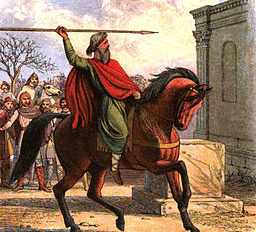 (Left, the high priest Coifi profanes ‘the Temple of the Idols’, from James William Edmund Doyle’s A Chronicle of England.)
(Left, the high priest Coifi profanes ‘the Temple of the Idols’, from James William Edmund Doyle’s A Chronicle of England.)
The Concilium Germanicum, the first council convened in 742-743 in the Germanic territory of the Frankish empire, also provided that ‘the people of God should not promote anything pagan, but reject and abhor all filthiness of the Gentiles’.
